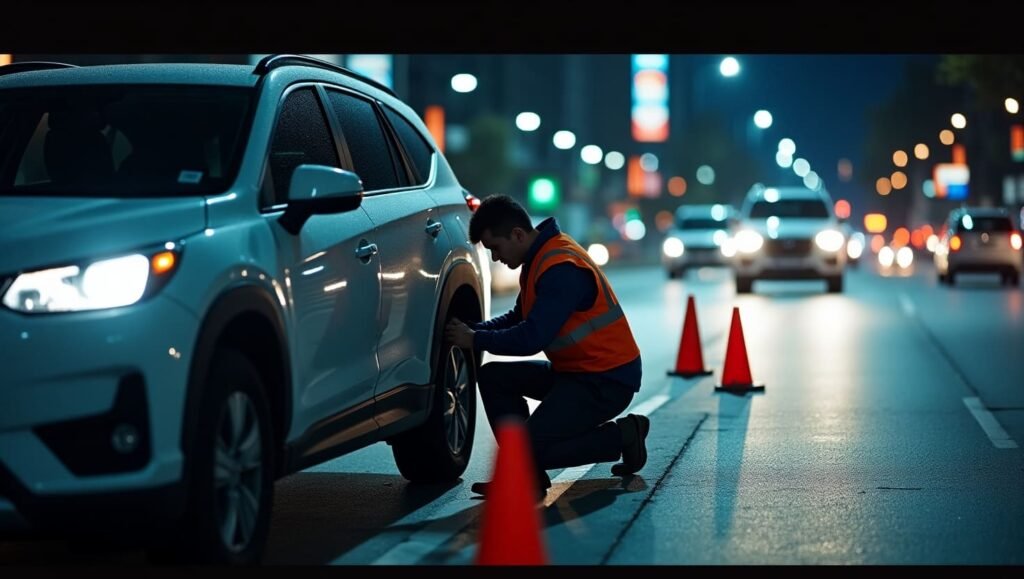Getting a flat tire is one of the most common automotive emergencies drivers face. Whether you’re commuting to work, taking a family road trip, or running errands around town, a sudden tire failure can leave you stranded and stressed. While knowing how to change a tire yourself is valuable, roadside assistance tire change services offer professional help that ensures your safety and gets you back on the road quickly.
Roadside assistance tire change services have become increasingly popular as drivers recognize the benefits of professional help over attempting dangerous roadside repairs themselves. These services provide trained technicians who arrive with the proper equipment, safety gear, and expertise to handle tire emergencies efficiently. From busy highways to remote rural roads, professional assistance can mean the difference between a minor inconvenience and a dangerous situation.
Modern vehicles often come with compact spare tires, complex lug nut patterns, and safety features that can make tire changes more challenging than in the past. Additionally, many drivers lack the physical strength, proper tools, or experience needed to safely change a tire, especially in adverse weather conditions or high-traffic areas. Understanding when and how to use roadside assistance tire change services can save you time, prevent injury, and ensure the job is done correctly.

Essential Tools Required for Changing a Tire
Before calling for roadside assistance tire change services, it’s helpful to understand what tools are needed for a proper tire change. Professional roadside technicians come equipped with comprehensive tool kits that ensure safe and efficient service.
Basic Equipment
A complete tire change requires several essential tools. The spare tire is obviously the most important component, but it must be properly inflated and in good condition. A jack capable of lifting your vehicle’s weight safely is crucial, along with a lug wrench that fits your wheel’s lug nuts. Many newer vehicles use specialized locking lug nuts that require a unique key, which professional roadside assistance tire repair services keep on hand for various vehicle makes and models.
Safety Equipment
Professional roadside assistance service truck operators prioritize safety above all else. They carry reflective triangles, emergency flares, and high-visibility vests to ensure visibility to other drivers. Heavy-duty flashlights and portable work lights enable safe operations during nighttime emergencies. Professional technicians also use wheel chocks to prevent vehicle movement during the tire change process.
Advanced Tools
Beyond basic equipment, professional services utilize torque wrenches to ensure lug nuts are tightened to manufacturer specifications. Tire pressure gauges verify proper inflation in the spare tire before installation. Some services carry portable air compressors to inflate low tires or provide temporary roadside assistance tire repair for minor punctures that don’t require immediate tire replacement.
Step-by-Step Guide to the Professional Tire Change Process
When you contact urgent roadside assistance, trained technicians follow a systematic approach to ensure your safety and proper tire installation. Understanding this process helps you know what to expect and how to prepare for their arrival.
Initial Assessment and Safety Setup
Professional technicians begin by assessing the situation and implementing safety measures. They position their roadside assistance service truck to provide maximum protection from traffic while ensuring easy access to your vehicle. Emergency lighting and reflective markers are deployed to warn approaching drivers and create a safe work zone.
The technician examines the damaged tire to determine whether a simple change is sufficient or if additional roadside assistance tire repair services might be needed. They also inspect the spare tire to confirm it’s in good condition and properly inflated before beginning the replacement process.
Vehicle Preparation
Before lifting the vehicle, the technician ensures it’s on stable, level ground whenever possible. The parking brake is engaged, and wheel chocks are placed behind the tires that will remain on the ground. This prevents any vehicle movement during the tire change process, which is particularly important on sloped surfaces or in windy conditions.
Tire Removal and Installation
The professional process involves loosening lug nuts before raising the vehicle, which prevents the wheel from spinning freely. Once the vehicle is properly supported by the jack, the lug nuts are completely removed and stored safely. The damaged tire is carefully removed, and the spare tire is mounted, ensuring proper alignment with the wheel bolts.
Lug nuts are then hand-tightened in a star pattern to ensure even pressure distribution. After lowering the vehicle so the tire contacts the ground but still supports some weight, the technician uses a torque wrench to tighten lug nuts to manufacturer specifications, preventing both under-tightening and over-tightening issues.
When to Call Roadside Assistance Instead of DIY
Many situations make roadside assistance tire change services the safer and smarter choice over attempting a DIY tire change. Professional help becomes essential when safety risks outweigh the benefits of self-reliance.
Dangerous Locations
Highway shoulders, especially during heavy traffic or poor weather conditions, present significant safety hazards for amateur tire changes. According to the National Highway Traffic Safety Administration, hundreds of people are injured or killed annually while performing roadside repairs. Professional roadside assistance technicians have training and equipment specifically designed for high-risk roadside situations.
Steep inclines, soft shoulders, and areas with limited visibility also warrant professional assistance. These conditions can cause jacks to slip or vehicles to roll, creating potentially fatal situations for inexperienced individuals attempting tire changes.
Physical Limitations and Equipment Issues
Not everyone has the physical strength required to remove lug nuts that may have been over-tightened or corroded. Elderly drivers, individuals with disabilities, or people recovering from injuries should always rely on roadside assistance tire change services rather than risk personal injury.
Missing or inadequate tools also necessitate professional help. A stripped lug nut, seized wheel, or missing jack key can turn a simple tire change into an impossible task without proper equipment.
Complex Vehicle Systems
Modern vehicles often have sophisticated systems that complicate tire changes. Tire pressure monitoring systems (TPMS) may require recalibration after tire changes. Some vehicles have specialized jacking points or unique spare tire storage systems that require professional knowledge to operate safely.
Electric and hybrid vehicles present additional challenges due to high-voltage systems and specific safety procedures. Professional roadside assistance tire repair technicians receive specialized training to handle these advanced vehicle technologies safely.
Choosing the Right Roadside Assistance Plan
Selecting appropriate roadside assistance tire change coverage requires careful consideration of your driving habits, vehicle type, and personal needs. Various options exist, from manufacturer warranties to independent service providers.
Coverage Options and Features
Comprehensive roadside assistance plans typically include tire changes, battery jumps, lockout assistance, and towing services. When evaluating plans, consider the number of service calls allowed per year, coverage area limitations, and response time guarantees. Some plans offer unlimited service calls, while others limit you to a specific number of incidents annually.
Premium plans may include additional services like fuel delivery, trip interruption coverage, and concierge services. For frequent travelers or those with older vehicles, these enhanced features can provide valuable peace of mind and convenience.
Service Provider Networks
Different roadside assistance service truck providers maintain varying network sizes and coverage areas. The American Automobile Association (AAA) operates one of the largest networks, while many insurance companies partner with national service providers to offer competitive coverage options.
Response times vary significantly between providers and locations. Urban areas typically receive faster service than rural locations, but the best providers maintain comprehensive coverage across their service territories. Research customer reviews and response time statistics when comparing providers.
Cost Considerations
Roadside assistance tire change plan costs vary widely based on coverage levels and provider networks. Basic plans may cost less than $50 annually, while comprehensive coverage with premium features can exceed $200 per year. Consider your vehicle’s age, your driving frequency, and your comfort level with DIY repairs when evaluating cost-effectiveness.
Some credit cards, insurance policies, and vehicle manufacturers include roadside assistance as a benefit. Review existing coverage before purchasing additional plans to avoid paying for duplicate services.
Tips for Maintaining Your Tires and Preventing Emergencies
Proactive tire maintenance significantly reduces the likelihood of needing urgently roadside assistance for tire-related emergencies. Regular inspection and proper care extend tire life while improving safety and fuel efficiency.
Regular Inspection Routine
Monthly tire inspections should include checking tire pressure, examining tread depth, and looking for signs of damage or irregular wear patterns. Use a tire pressure gauge to verify inflation levels match manufacturer recommendations, typically found on a sticker inside the driver’s door frame.
Inspect tire sidewalls for cracks, bulges, or embedded objects that could cause sudden failure. Check tread depth using the penny test or a dedicated tread depth gauge. Tires with less than 2/32 inch of tread depth should be replaced immediately to maintain safe traction.
Proper Inflation and Rotation
Maintaining proper tire pressure is crucial for tire longevity and vehicle safety. Under-inflated tires wear unevenly and are more susceptible to damage from road hazards. Over-inflated tires provide less contact with the road surface, reducing traction and increasing wear in the center of the tread.
Regular tire rotation ensures even wear patterns across all four tires. Most manufacturers recommend rotation every 5,000 to 8,000 miles, following specific patterns based on whether your vehicle has directional tires or different front and rear tire sizes.
Seasonal Considerations
Different seasons present unique challenges for tire maintenance. Summer heat can increase tire pressure, while winter cold causes pressure to drop. Temperature changes of 10 degrees Fahrenheit can alter tire pressure by 1-2 PSI, making seasonal adjustments necessary.
Consider seasonal tire changes in areas with severe winter weather. Winter tires provide superior traction in cold conditions, while all-season tires offer better performance in moderate climates year-round. Proper seasonal tire storage prevents damage during the off-season.

Understanding Emergency Response Procedures
When you need roadside assistance tire change services, following proper procedures ensures a quick response and safe service delivery. Preparation and clear communication with service providers streamline the assistance process.
Immediate Safety Steps
Upon discovering a flat tire, safely exit traffic and park in the safest location possible. Turn on hazard lights immediately and raise your hood if safe to do so, which signals distress to passing motorists. Exit the vehicle on the side away from traffic and move to a safe location while waiting for help.
If you must remain near the vehicle, stay alert and prepared to move quickly if another vehicle approaches your location. Wearing bright clothing or a reflective vest increases your visibility to other drivers and roadside assistance service truck operators.
Effective Communication with Service Providers
When calling for urgently roadside assistance, provide clear information about your location, vehicle description, and the nature of your emergency. Use mile markers, nearby exits, or landmark descriptions to help technicians locate you quickly. GPS coordinates from your smartphone can provide precise location information.
Describe your tire problem accurately, including whether you have a spare tire available and any special equipment your vehicle might require. This information helps dispatchers send appropriately equipped technicians and reduces service time.
Preparing for Technician Arrival
While waiting for roadside assistance tire change services, gather your vehicle registration, insurance information, and roadside assistance membership details. Clear the area around your vehicle of personal belongings that might interfere with the tire change process.
If possible, locate your spare tire and jack to expedite service once the technician arrives. However, avoid attempting any repairs yourself unless you’re in immediate danger and have proper experience and equipment.
Personal Protection
Wear appropriate clothing for roadside emergencies, including closed-toe shoes and long pants that protect against sharp objects and hot vehicle components. Bright or reflective clothing improves visibility to other drivers and emergency responders.
Stay alert and maintain situational awareness while waiting for assistance. Avoid distractions like phone calls or loud music that might prevent you from hearing approaching vehicles or emergency responders. Keep emergency supplies like water, snacks, and first aid kits easily accessible.
Professional Service Excellence and Industry Standards
The roadside assistance tire change industry maintains specific standards and best practices that ensure consistent, safe service delivery across different providers and situations. Understanding these standards helps consumers make informed choices about service providers.
Technician Training and Certification
Professional roadside assistance technicians undergo comprehensive training programs that cover vehicle safety systems, proper tool usage, and emergency response procedures. Many technicians hold certifications from recognized organizations that validate their expertise and commitment to safety standards.
Continuing education ensures technicians stay current with evolving vehicle technologies and safety protocols. Electric vehicles, advanced driver assistance systems, and new tire technologies require ongoing training to maintain service quality and safety standards.
Service Quality Metrics
Reputable roadside assistance tire repair providers track response times, customer satisfaction scores, and safety incident rates to maintain high service standards. Average response times typically range from 30 to 60 minutes in urban areas, with longer times expected in rural locations or during severe weather conditions.
Customer feedback systems help providers identify areas for improvement and recognize exceptional service delivery. Many companies publish service statistics and customer testimonials that help consumers evaluate service quality before selecting a provider.
Preparing for Long-Distance Travel
Extended road trips and long-distance travel require special preparation to minimize the risk of tire emergencies far from home. Proper planning and vehicle maintenance reduce the likelihood of needing urgently roadside assistance in unfamiliar locations.
Pre-Trip Vehicle Inspection
Comprehensive pre-trip inspections should include detailed tire examinations, checking spare tire condition, and verifying that all emergency equipment is present and functional. Measure tread depth on all tires and replace any that are approaching minimum safe levels before departure.
Inspect tire sidewalls carefully for signs of aging, cracking, or damage that might not be immediately apparent but could cause failures during extended highway driving. Consider professional tire inspection if you’re uncertain about tire condition or have concerns about specific wear patterns.
Emergency Kit Preparation
Assemble a comprehensive roadside emergency kit that includes basic tools, safety equipment, and comfort items for extended waits. Include extra water, snacks, blankets, and phone chargers to maintain comfort and communication capability during emergencies.
Research roadside assistance tire change coverage along your planned route, including service provider networks and coverage limitations. Some plans have geographical restrictions or longer response times in certain areas, making backup planning essential for comprehensive protection.
Trust Mobile Tire Service LLC for Professional Roadside Assistance
When you need reliable roadside assistance tire change services, Mobile Tire Service LLC provides professional, prompt assistance backed by years of industry experience. Our trained technicians carry comprehensive tool kits and safety equipment to handle tire emergencies safely and efficiently, ensuring you get back on the road quickly without compromising your safety or vehicle integrity.Mobile Tire Service LLC understands that tire emergencies don’t follow convenient schedules, which is why we provide 24/7 urgently roadside assistance coverage throughout our service area. Our roadside assistance service truck fleet is strategically positioned to minimize response times while maintaining the highest safety standards for both our technicians and customers.


